As a veterinarian, I often have to fill in identification papers and define the different colors and markings of the horses. This is not always easy as the coat colors and coat patterns can vary greatly between horses. To help you to learn all about common horse coat colors and more unusual colors and patterns, I have put together this article and I hope you enjoy it and learn a lot.
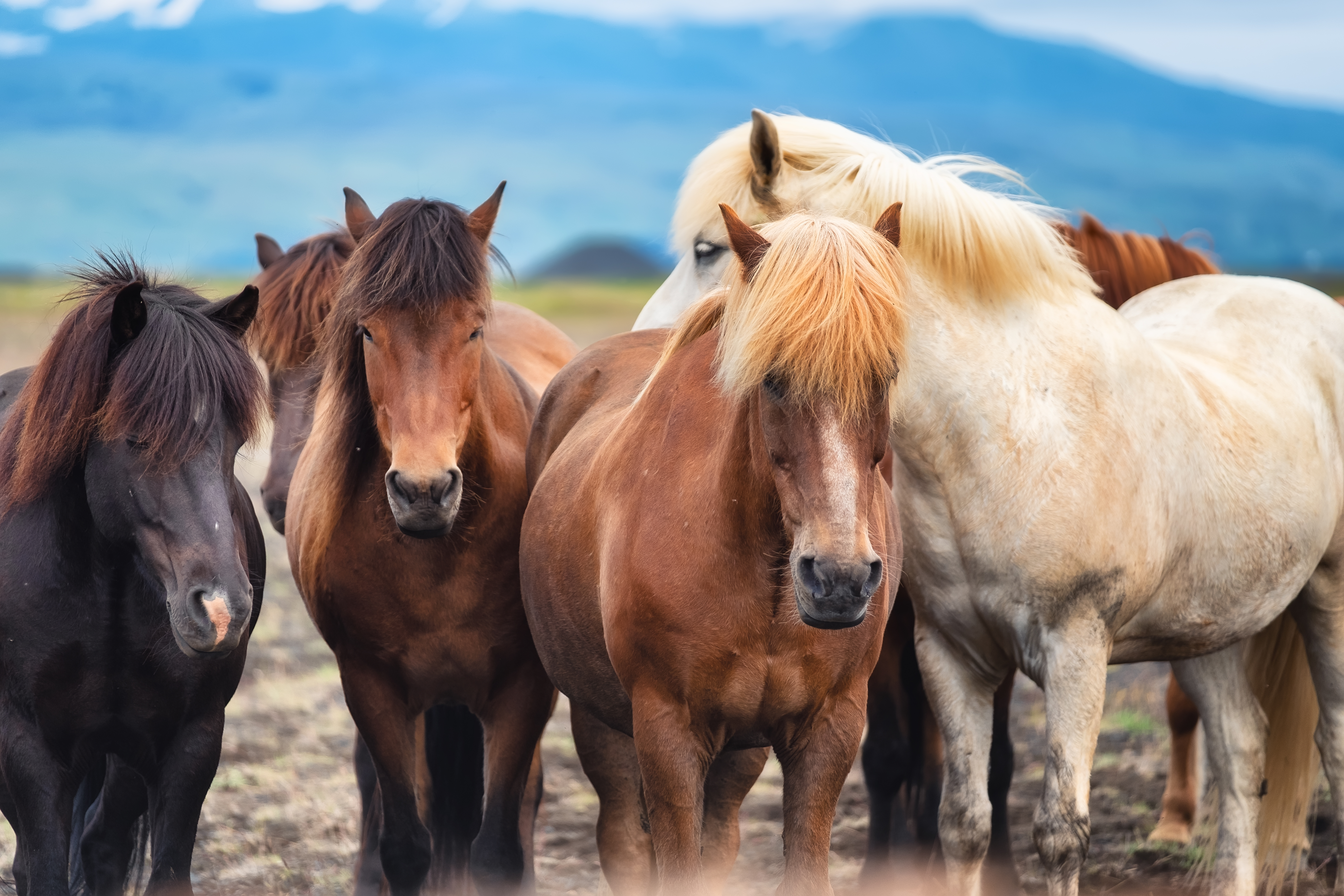
The basic horse colors
Horses have three (or four) basic colors:
- black
- bay
- chestnut
Sometimes the color brown is also included as a basic color. Then there are genetic factors that influence the basic colors and this enables the horse´s coat color to be expressed in a wide variety of ways with different patterns and shades.
It may be useful to know that the definition and description of horse colors vary a little from country to country. In some countries, the color of the hair is used, and in others the color of the skin (e.g. pale or black skin) as the general term. The variety of coat colors is huge and the specific color of a horse can sometimes be very difficult to determine. Sometimes the best way to be sure of the horse’s coat color is by taking a genetic test.
The basic colors are the most common horse colors in many different horse breeds. Here is some more information about the basic colors:
Black: a basic color with black body, mane and tail
The following features are common to all black horses:
- the body has black base color, or almost black
- they have a black mane and black tail.
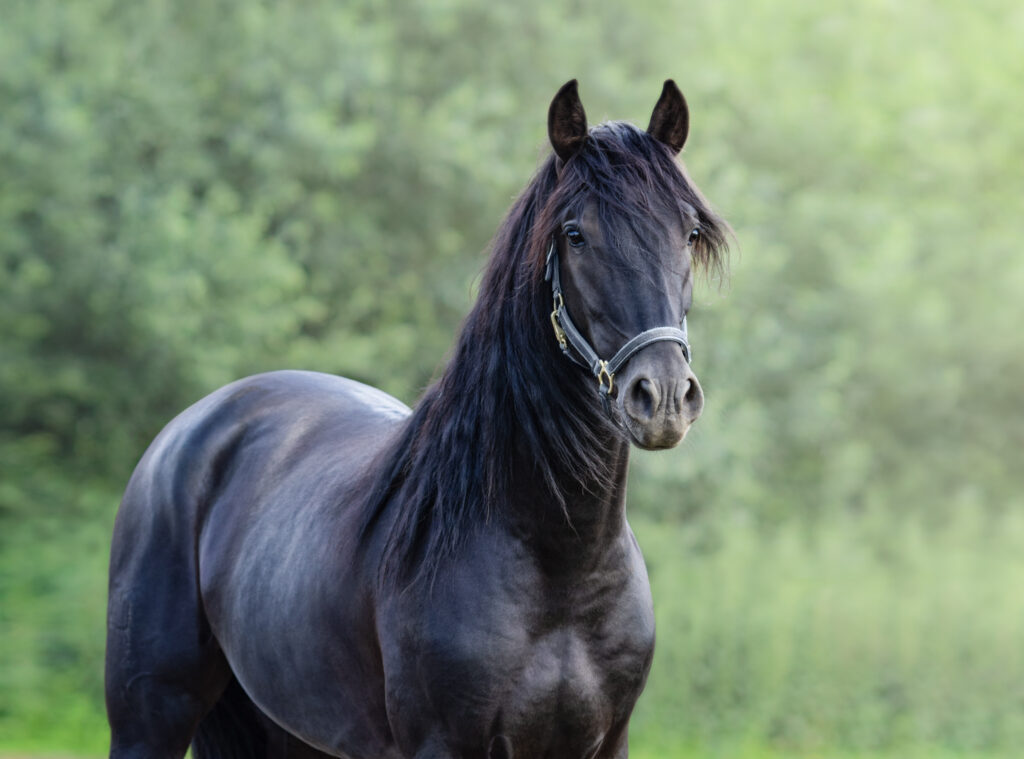
There are different shades of black:
- Jet black or raven black: coat, mane, and tail are deep blue-black and do not fade when exposed to sunlight. A solid color horse like this is also called a true black horse.
- Summer or fading black: black coat which fades to brown-black when exposed to sunlight, mane and tail generally remain jet black.
- Seal brown (Pangare): coat, mane, and tail black, lighter points on muzzle, under the belly, inside of thighs.
In some breeds, black is the only approved color, for example in Friesian horses. The color black is also common in Shetland ponies and warmbloods. If two black horses are bred, the foal can be either black or chestnut.
Bay: horses with brown bodies and black legs, mane and tail
The following features are common to all bay horses:
- the body color is brown.
- the coat with brown color comes in many different shades (pale yellow/red to dark brown)
- mane and tail are black
- lower legs are black.
It is the agouti gene that affects so that the black color is confined to the peripheral parts of the horse (mane, tail, legs, and edge of the ears)

There are many shades of bay such as:
- Dark bay or mahogany bay: the coat color is dark brown.
- Blood or red bay: the coat color is red-brown.
- Light bay: the coat color is light bay.
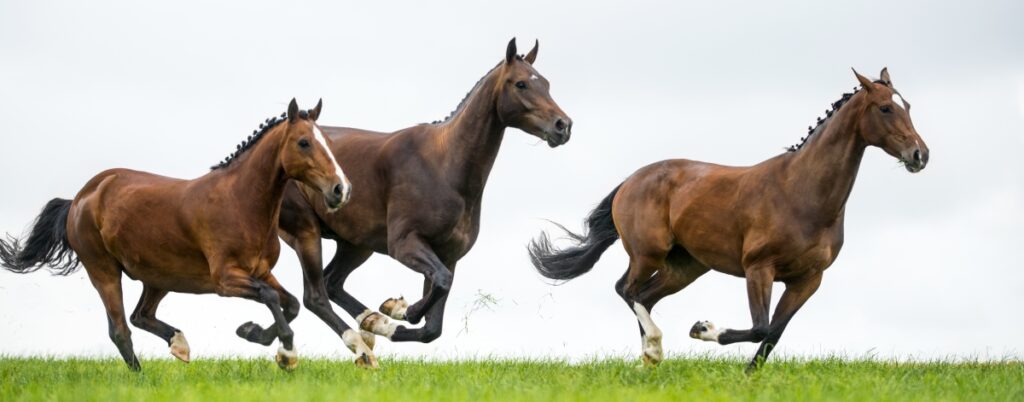
The bay color is one of the most common colors in many breeds. But the color bay doesn’t exist in some breeds such as Friesian horses, Norwegian Fjord horses, Haflinger and Sufford Punch. In the British Cleveland bay breed, all horses are bay.
Chestnut: red horses with no black pigment
Chestnut horses have no black pigment and therefore no black points whatsoever which differs them from the other two basic colors, they only have red pigment therefore sometimes called red horses. Thus, there can be a great variation and many various shades of red coats.
- the coat can be any variation of brown (pale yellow or red colors to dark brown)
- mane and tail can be any variation of brown (pale yellow/red to dark brown) but are never much darker than the coat color
- the legs are the same color as the rest of the coat.
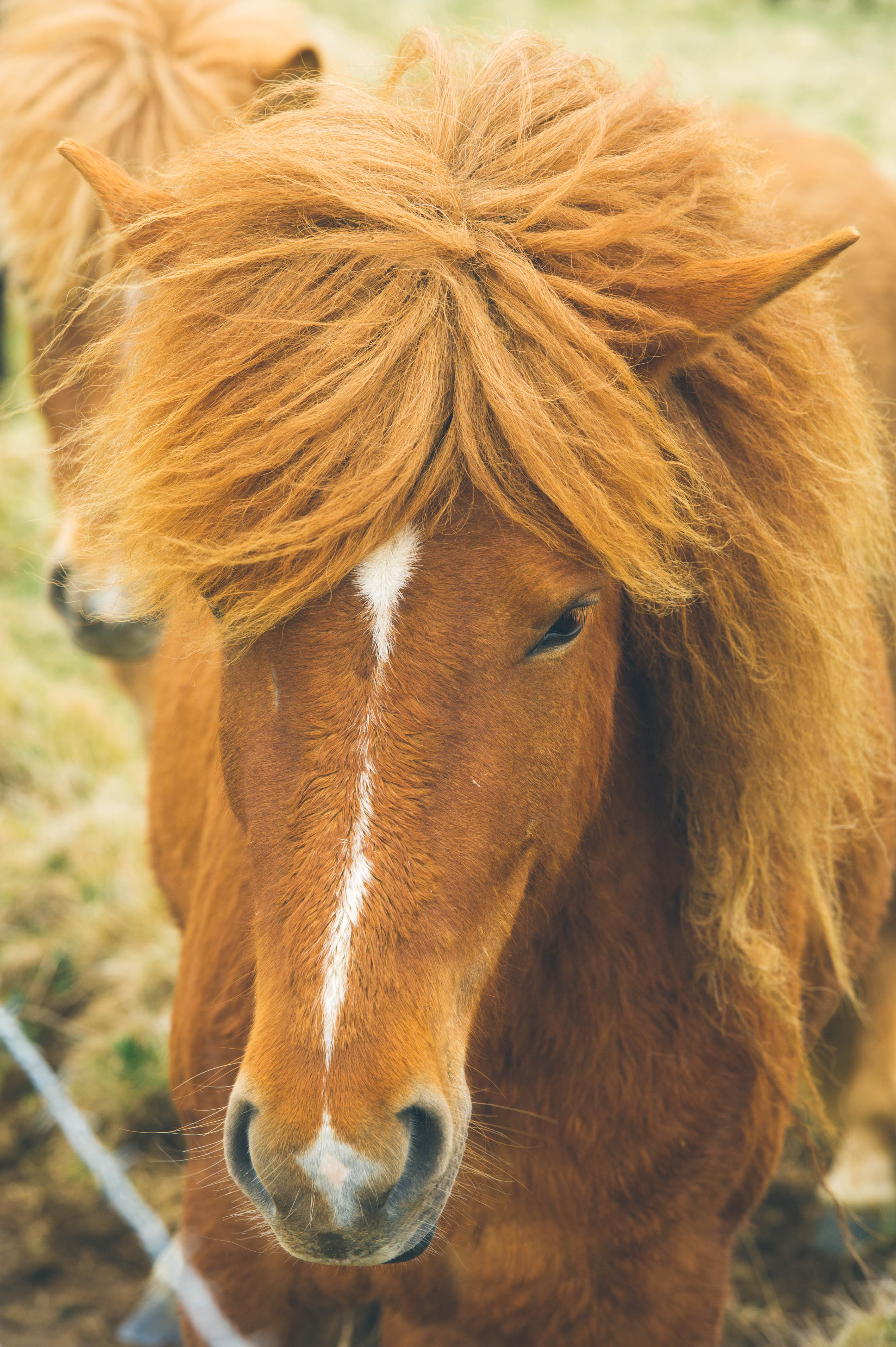
Different shades of chestnut:
- Light chestnut: the coat is light brown (yellowish or reddish), mane and tail are the same or lighter.
- Golden chestnut (in North America horses with golden coats are called sorrel horse): the coat is orange-red with a metallic sheen, mane and tail are the same or slightly darker.
- Dark chestnut: the coat is dark reddish-brown, mane and tail are the same.
- Liver chestnut: the coat is dark coffee brown, sometimes almost black with a reddish hue, the mane and tail are the same, sometimes bleached slightly at the tips.
- Chestnut with flaxen mane and tail: coat is a shade of chestnut (from light to dark), mane and tail several nuances lighter (yellowish to cream) – this is presumably a genetic modification.
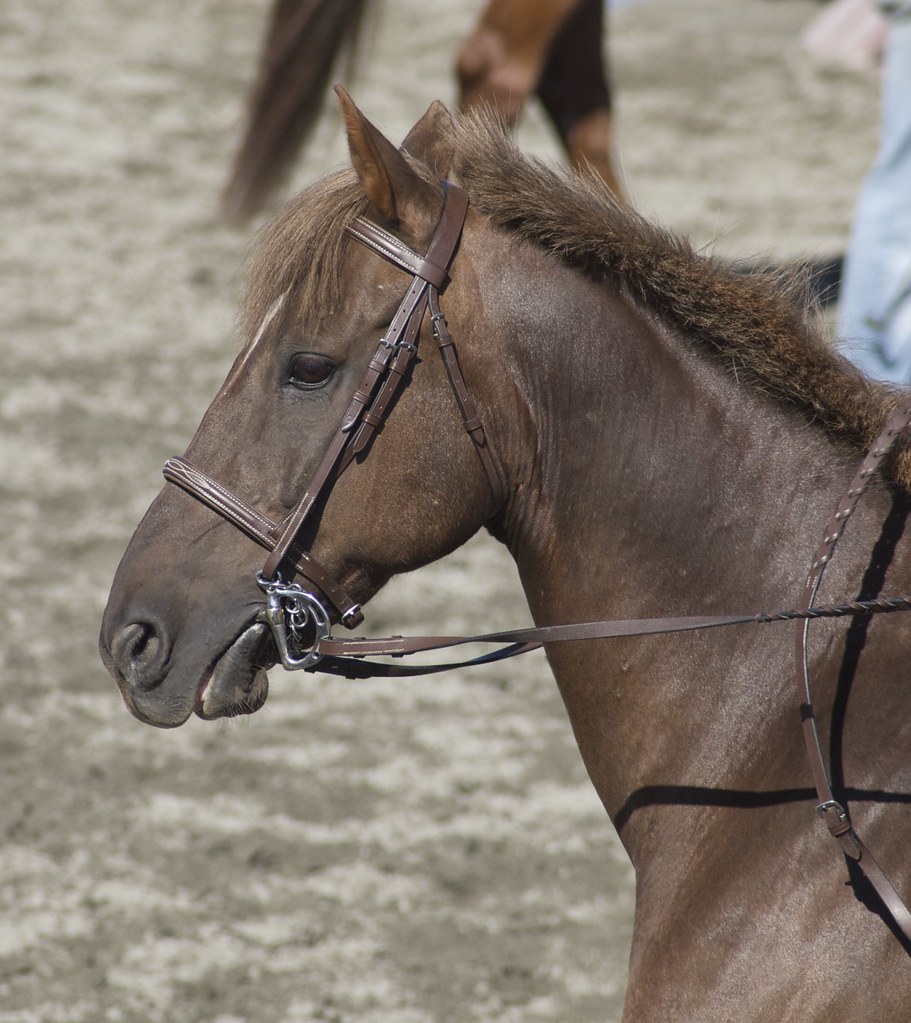
Photo: “Liver Chestnut” by Just chaos is licensed under CC BY 2.0.
The chestnut is more likely to have large white markings and more white ticking (white hairs mixed with the chestnut color) than horses with other base colors. If you mate two chestnuts, the foal will always be chestnut-colored. In some breeds, only the color chestnut is allowed, for example, Haflinger.
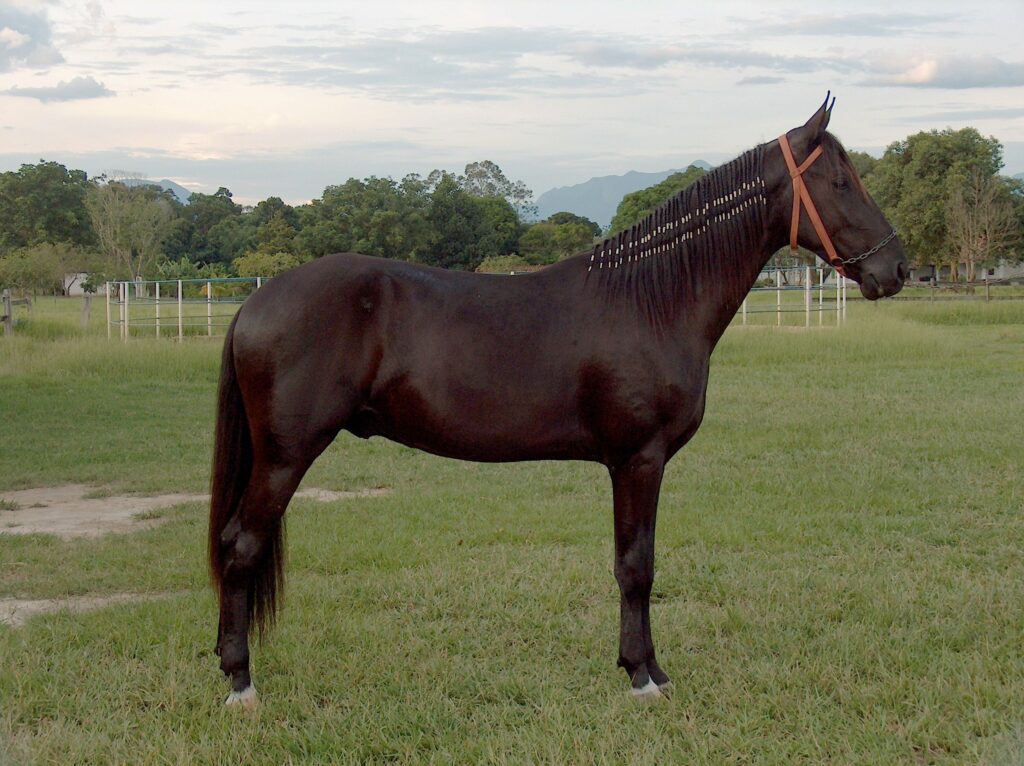
Photo: “File:Black Campolina male 2 years.JPG” by Amazona01 is licensed under CC BY-SA 3.0.
Brown: black and brown body, black legs, mane and tail
A brown horse has a mixture of black and brown pigment in the dark brown coat with black legs, mane, and tail. Brown horses have darker brown hair than bay horses.
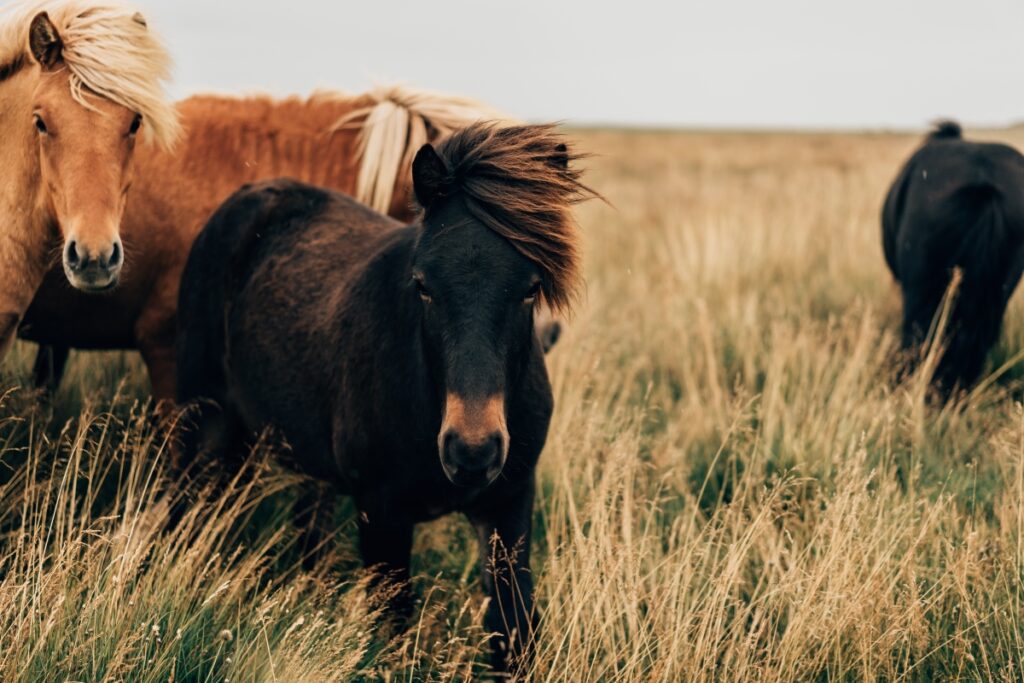
Genetic color modification – diluting factors
Modifying genes that dilute the horse’s basic coat color e.g. makes them paler. Diluting factors in horses modify the horse’s basic coat colors mostly over the entire body.
Dun factor: dun horses with dorsal stripe and zebra stripes on legs
The gene affects both red and black pigments but does not affect the hair of the mane, tail, and lower legs. This dilution gene gives the dun horses a pale coat with a prominent dorsal stripe and occasionally zebra stripes on its legs. The dorsal stripe extends from the forehead to the back of the tail. Sometimes you hear the term zebra dun when the stripes are present. It is a dominant gene so if either the mare or stallion has the color the foal will inherit it.

Photo: “File:Dun Horse Dorsal Stripes.jpg” by Arsdelicata is licensed under CC BY-SA 3.0.
| Basic color | Dun factor modifying basic colors |
|---|---|
| Chestnut | Red dun |
| Bay | Dun or Bay dun |
| Black | Blue dun or Grullo |
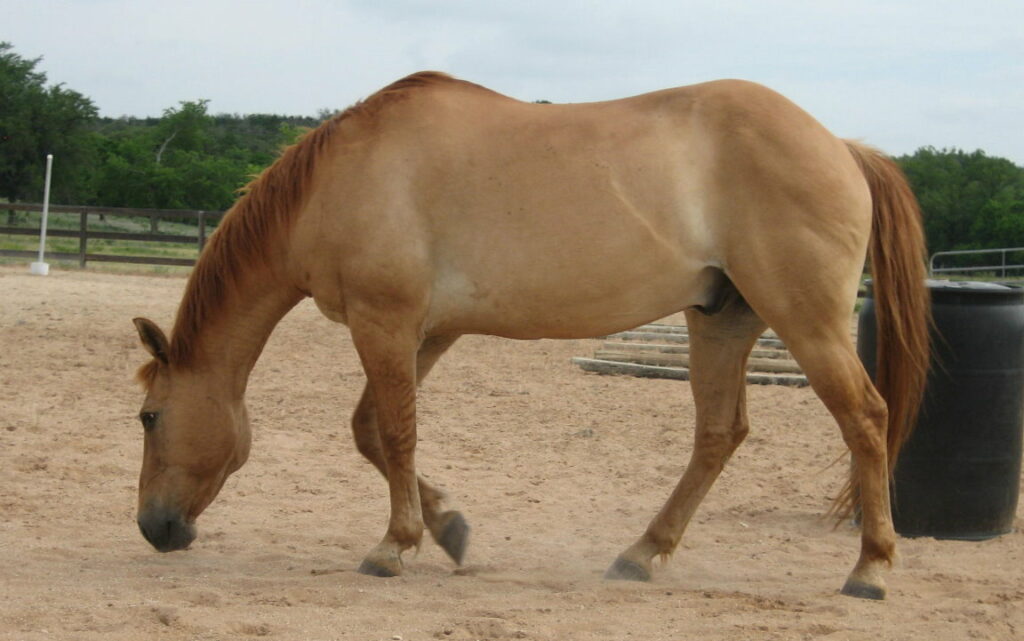
Photo: “File:Walking Red Dun.jpg” by jumpinghooves is licensed under CC BY 2.0.


Photo: “File:Sorraia horses varying hues of mouse dun.jpg” by Lynne Gerard is licensed under CC BY-SA 3.0.
Cream factor: yellow/cream/white horses, sometimes with blue eyes
The cream factor mainly affecting red pigments therefore chestnuts get lighter colors in both the coat and the hair of the main and tail. The cream gene has an incomplete dominant trait. Horses with two cream genes, particularly when the base coat color is bay or chestnut will get pale skin and blue eyes. These horses are therefore also known by the term blue eyed cream (BEC). This is not to be confused with true albinism which is not seen in horses.
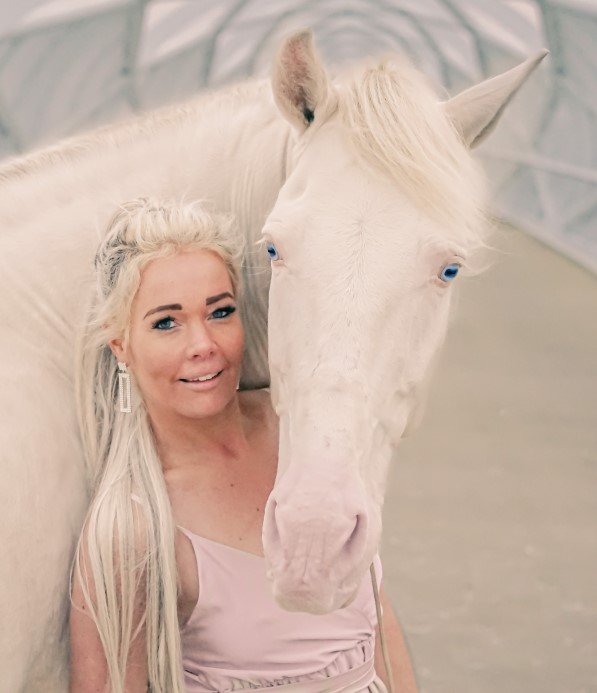
| Basic color | Cream factor modifying basic colors – one gene | Cream factor modifying basic colors – two genes |
|---|---|---|
| Chestnut | Palomino horse or Isabelle | Cremello or BEC |
| Bay | Buckskin horses | Perlino |
| Black | Smokey black | Smokey cream |
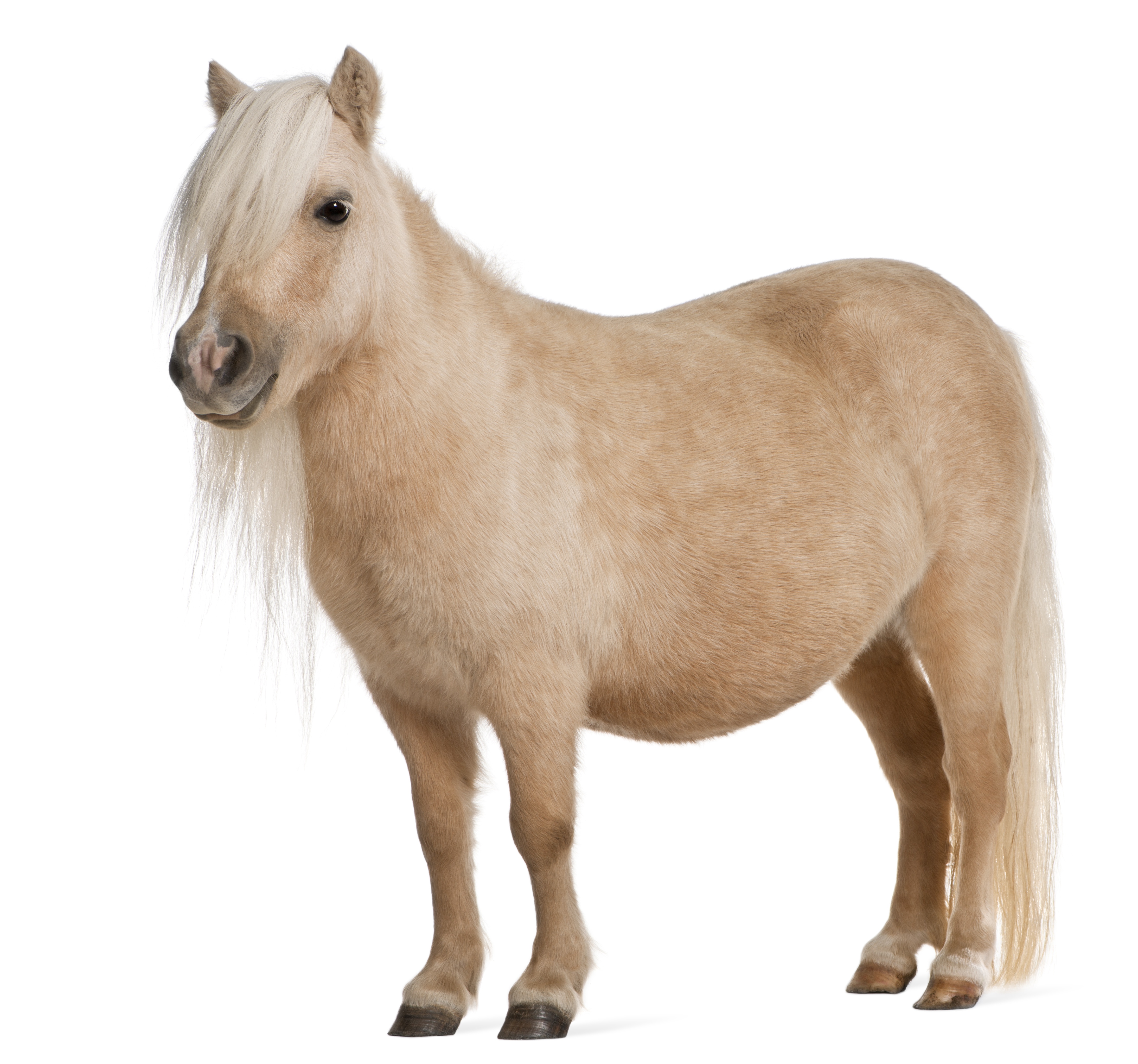
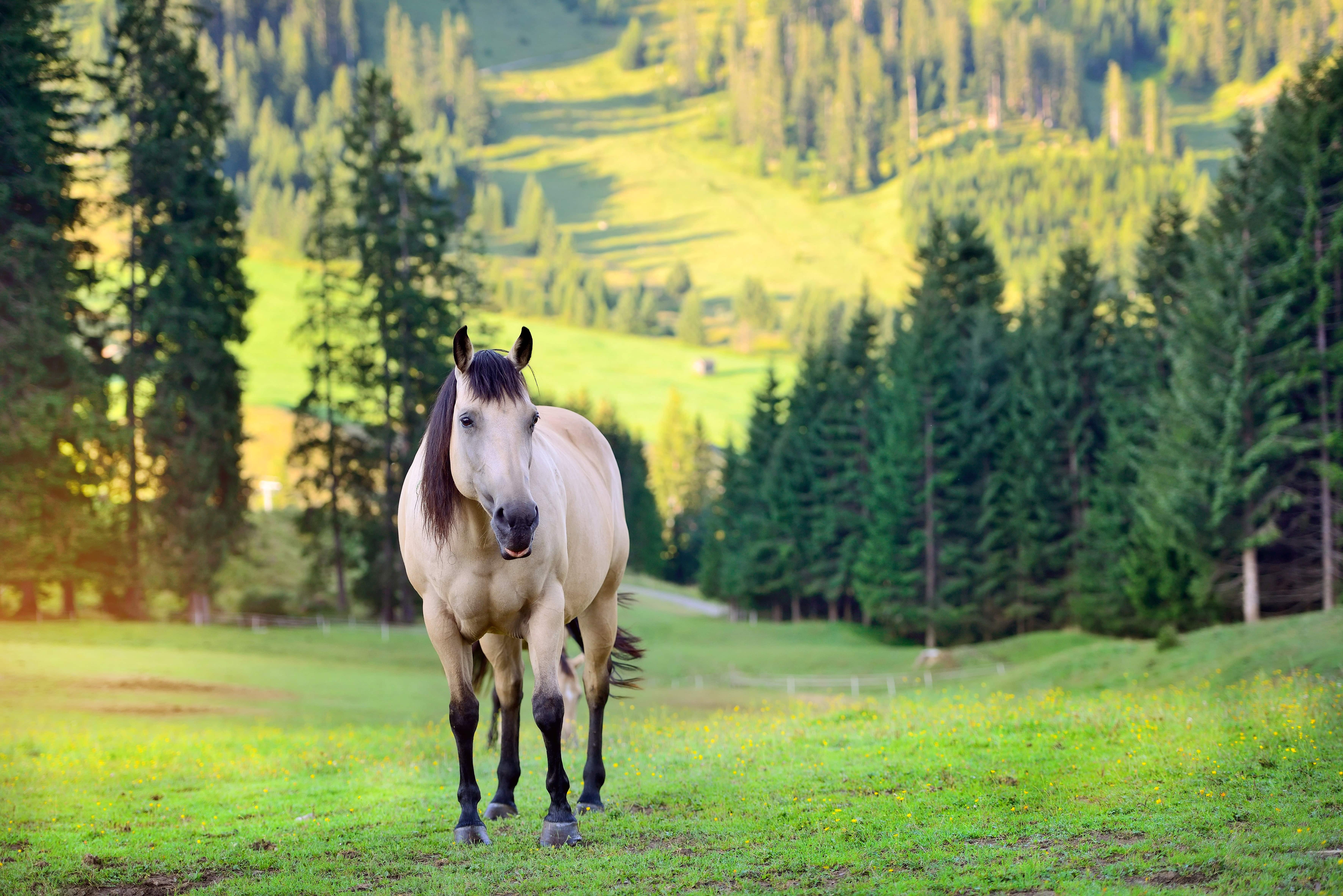
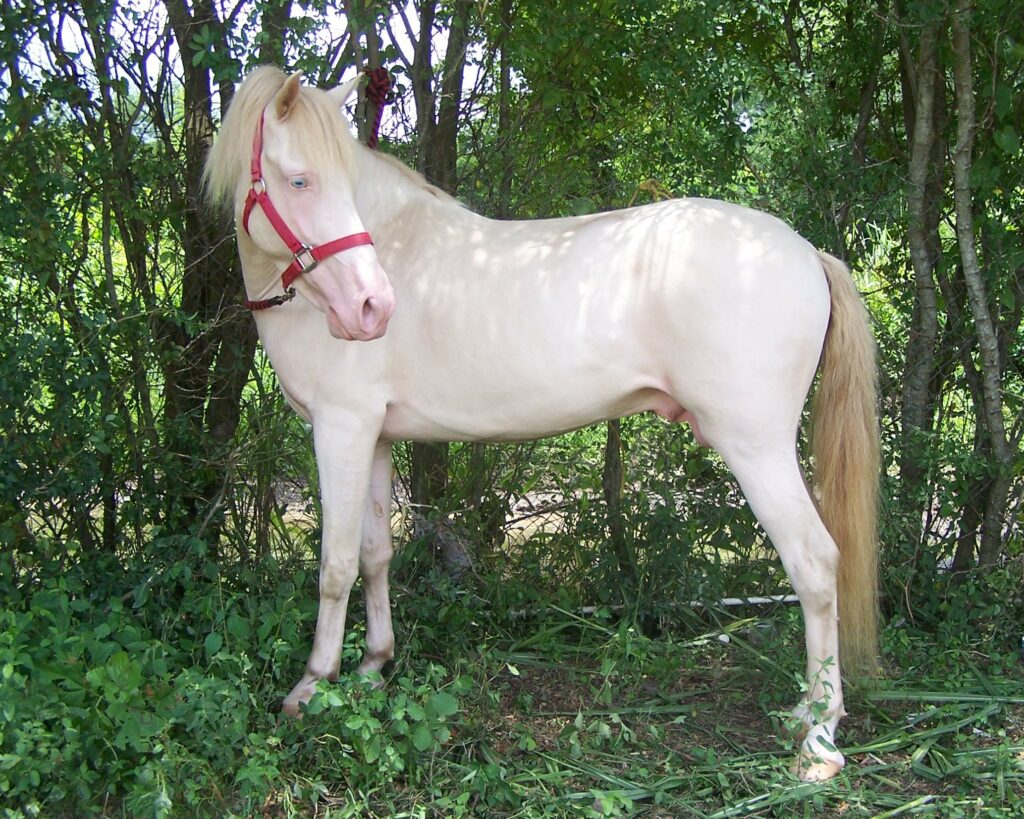
Photo: “File:Perlino-color-horse-100 6908.JPG” by Arsdelicata is licensed under CC BY-SA 3.0.
Champagne factor: rare color with freckles
The champagne factor is a dominant gene that affects the horse’s coat more than the mane and tail of the horse. The horse has a lighter color of skin and they have honey-colored or pale brown eyes. The muzzle skin often gets freckled. The champagne factor can be seen in e.g. Spanish mustang, Tennessee walking horse, and American quarter horses but is quite rare. The color doesn´t exist in Europe.
| Basic color | Champagne factor modifying basic colors |
|---|---|
| Chestnut | gold champagne |
| Bay | amber champagne |
| Black | classic champagne |

Photo: “Highly Intoxicated yearling” by Carrot Mama is licensed under CC BY-ND 2.0.
Silver factor: affectin black pigment in mane and tail
The silver factor is a dominant gene that’s affecting only black pigment. Mostly affect the horse’s mane and tail rather than coat color. Do not exist in all breeds but may be seen in Icelandic horses, Shetland ponies, and Rocky Mountain ponies. There is a risk of blindness because of defects in the eye linked to the silver factor but the horse needs double genes to get the disease MCOA.
| Basic color | Silver factor modifying basic colors |
|---|---|
| Chestnut | No change because no black pigment |
| Bay | Bay or red silver |
| Black | Classic or chocolate silver |

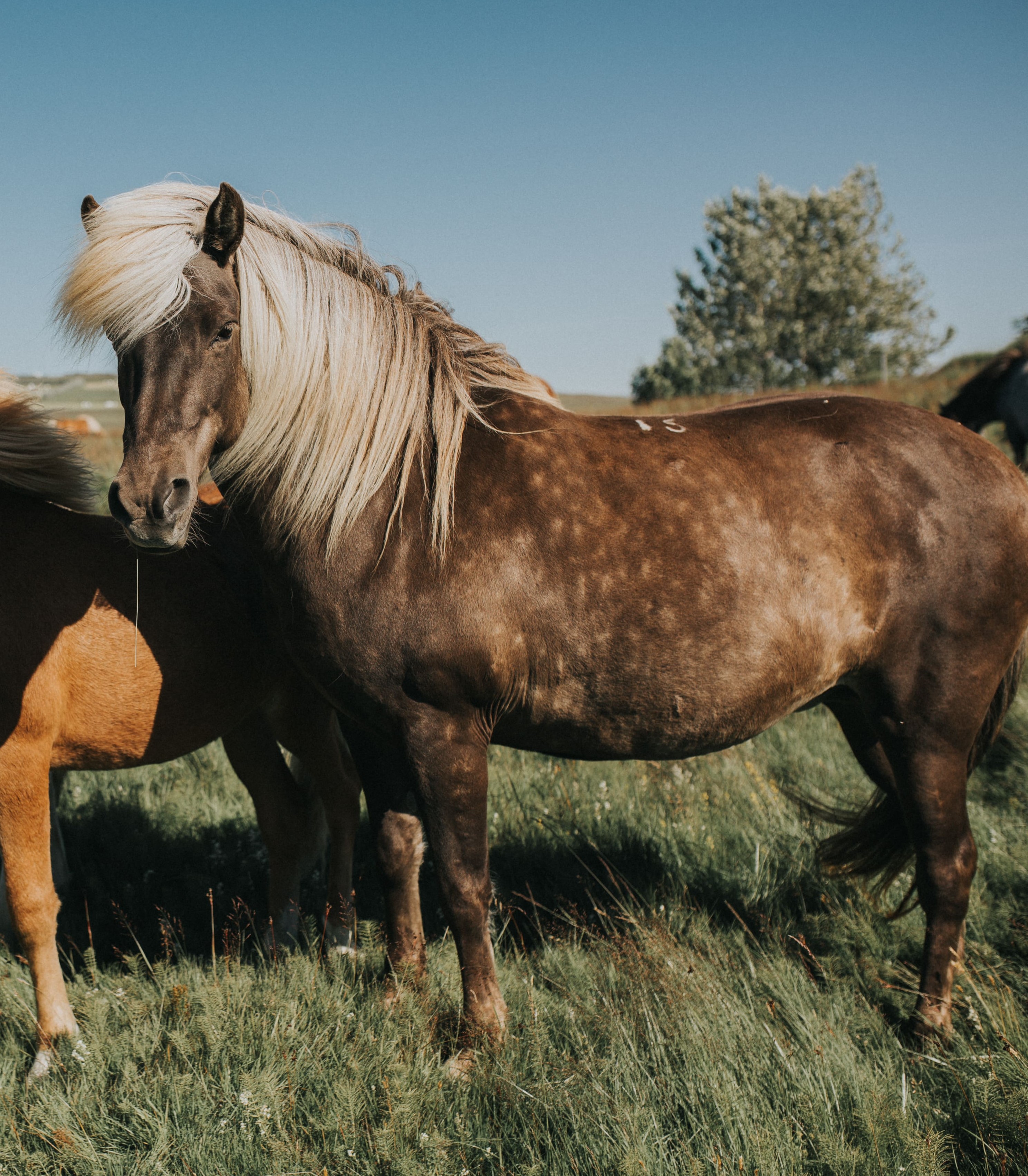
Genetic color modification – Graying factors
Greying factors are genes that mix white hair with the original color and you get gray horses. When it is progressive the horse’s color is called grey and when it is non-progressive and limited to some body parts the color is called roan.
The Gray factor: making the horse progressively white
The grey factor is a dominant gene so the horse only needs one gray gene and the basic color hairs will then turn gradually white. If you have a foal with a gray coat, one of the parents must be grey. The color of the underlying skin will not change. The foal is not born grey or white but with its original color. Then it differs a lot in how quickly it will turn completely white, ranging from 8-20 years. So it goes from the original color, from dark grey to light gray with dark points on the legs, and then finally turns pure white. The grey factor is linked to melanomas and it is thought that the risk is increasing with double grey factors. The grey factor is common in Arabian horses and Lipizzaners. Older grey horses have white manes and tails.
Different shades of Grey:
- Dapple grey – white circular patches surrounded by margins of darker hair (original color). Also called dappling.
- Flea-bitten grey – many small darker, usually brown, spots are seen when the horse gets whiter. Most common in Arabians.
- Steel grey – black/dark brown horse whit just a little bit of white hair looking dark grey
- Rose gray – chestnut/bay horse getting grey with a rose-pink sheen

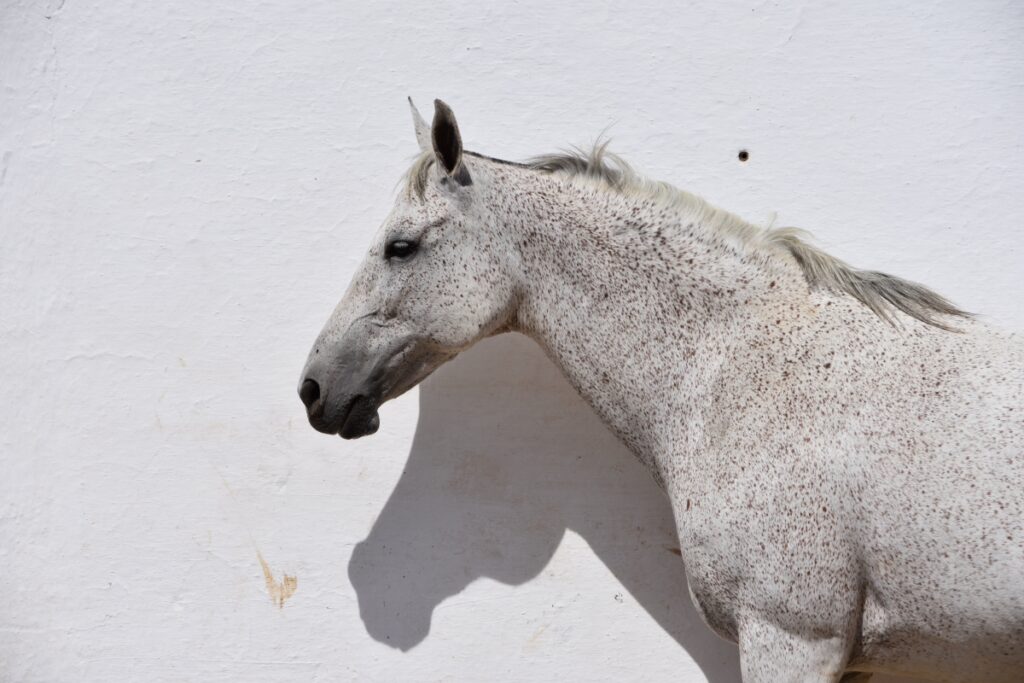
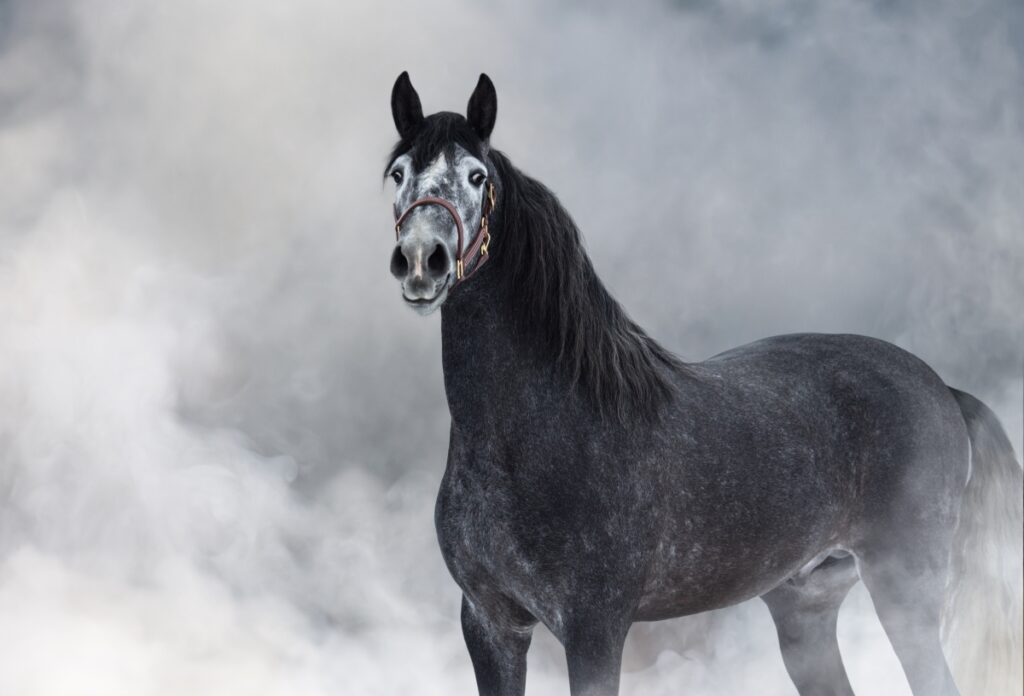
The Rone factor: non progressive greying with seasonal change
The roan gene is non-progressive greying only affecting the neck and body. So the roan horses keep their basic color in the head, legs, mane, and tail. There will be a seasonal change in the color of the coat – the horse will look lighter in the winter than in the summer. It is a dominant gene.
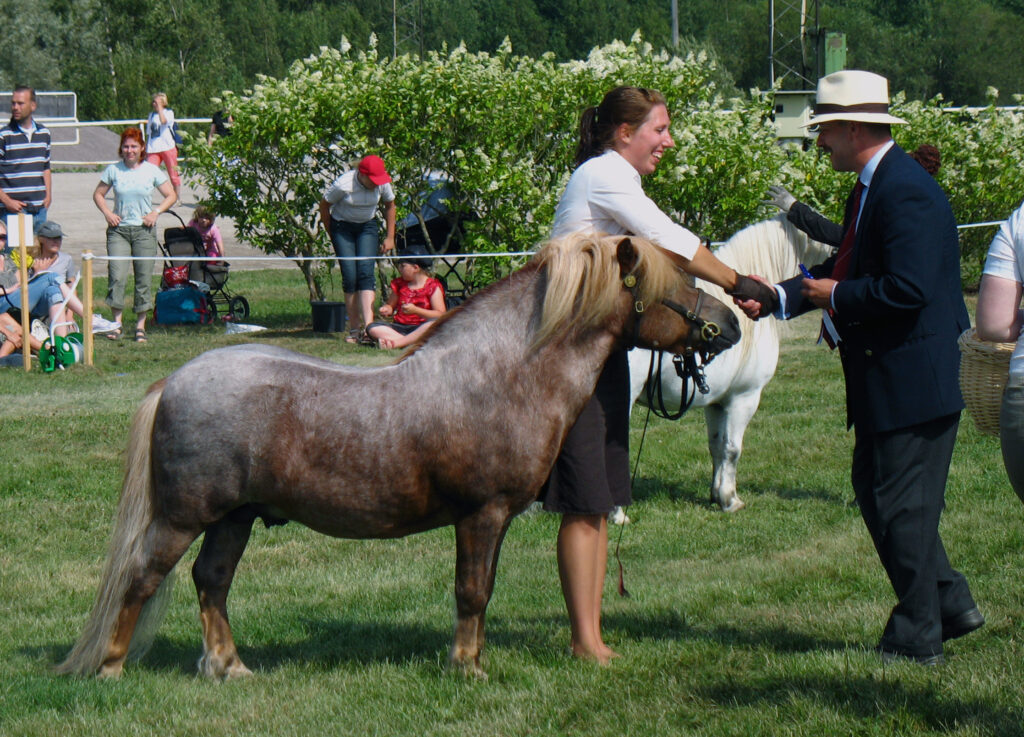
Photo: “File:289-o-Galant-SWE-71-SH-03.jpg” by Own work is licensed under CC BY-SA 3.0.
| Basic color | Roan factor modifying basic colors |
|---|---|
| Chestnut | strawberry roan |
| Bay | red roan or bay roan |
| Black | blue roan |

Photo: “File:Red roan Quarter Horse.jpg” by Betty Wills (Atsme) is licensed under CC BY-SA 4.0.
Genetic color modification – White patching factors
The horse gets distinctly defined white patches between patches of the original color. These horses are also called pinto horses. Pinto means painted in Spanish. White coat patterns are not to be confused whit white markings which are smaller and not extending all over the body. White patching genes can be combined with any base color.

| General term | Color | Country |
|---|---|---|
| Piebald | Black horse with white patches | UK |
| Skewbald | Another color than black mixed with white patches. | UK |
| Colored horse | Horse with any color white patches or spots | UK |
| Pinto | Colored horse, pinto added to the base color of the horse | US |
| Paint | American Quarter horse with white patches and any other basic color. | US |

Photo: “Chestnut Paint Horse” by Goldie May is marked with CC0 1.0.
The white patterns can vary according to different genes:
Tobiano: the most common white patching
The tobiano factor generates white patches with more or less vertical orientation called the tobiano pattern. The limbs are often white, and the white patches usually extend across the back. The head is often in the basic color with white markings. The tobiano is the most common type of white patching. Dominant gene so a tobiano foal must have at least one tobiano parent. It varies from small to large patches of white. Tobiano is often seen in Paint horses and Shetland ponies.

Overo: white patching on the horse’s lower part and underside
The overo factor usually gets highly irregular white patches with a more horizontal spreading along the side and underside of the horse. The head is often white with blue eyes. In a frame overo, the white patches are mainly on the side of the body and neck with the base color on the legs and along the back. In horses, with a splashed white overo factor the white patches are mostly on the legs, belly, underside of the neck, and head. Looking like the horse had been dipped in white paint.

Sabino: white legs and jagged-edged patches
The Sabino factor looks similar to splashed white overo patching. It often has four white legs and white, small abdominal patches or dots with jagged edges. White ticking often appear around the spots and in some cases all over the horse. Commonly seen in Clydesdale, Shire horses, and welsh ponies.

Photo: “Shire Horses Ploughing” by flintman45 is licensed under CC BY-SA 2.0.
Genetic color modification – Spotting factor
Spotting factor can influence the basic color in many different ways
- Roaning effect (white hair mixed with the basic color)
- White spots on the colored coat
- Dark spots on white background
The spotting factor is also called the Leopard factor because of the spotted appearance. It is very usual in appaloosas, knabstruppers, and noriker horses. They always have white sclera in their eyes.
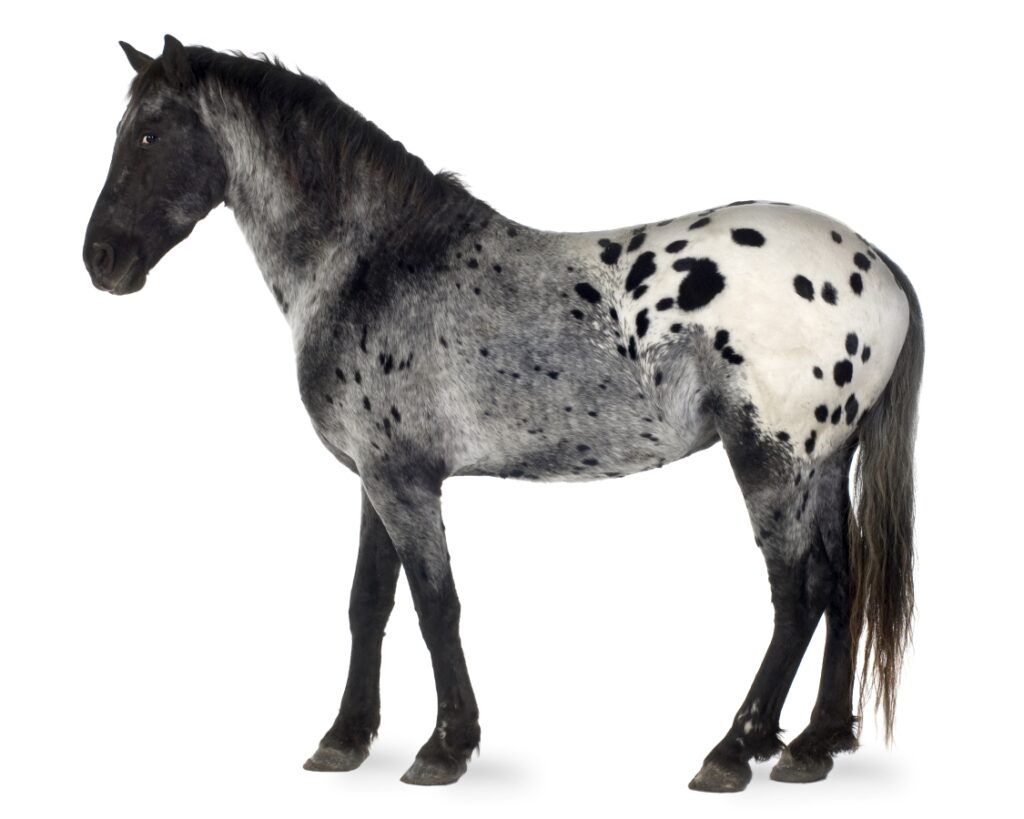
| Blanket | a white area over the croup, sometimes called a snow cap. |
| Blanket with spots | a white area with spots in the horse’s basic color. |
| Leopard | an entirely white horse with well-defined darker spots. The spots are in the horse’s base color and can vary in number and size. The eyes often have white sclera. The skin around the eyes and muzzle is often pale and mottled. Horses with leopard factor genes often have very little hair in the mane and tail. |
| Snowflake | a horse with white spots or flecks on a darker basic color. |
| Varnish or marble roan | progressive roaning with the absence of white hair over bony prominences such as limbs, facial crest, point of the hip, and point of the elbow. |
| Roan blanket | roaning over the hip and croup, with or without additional spots. |
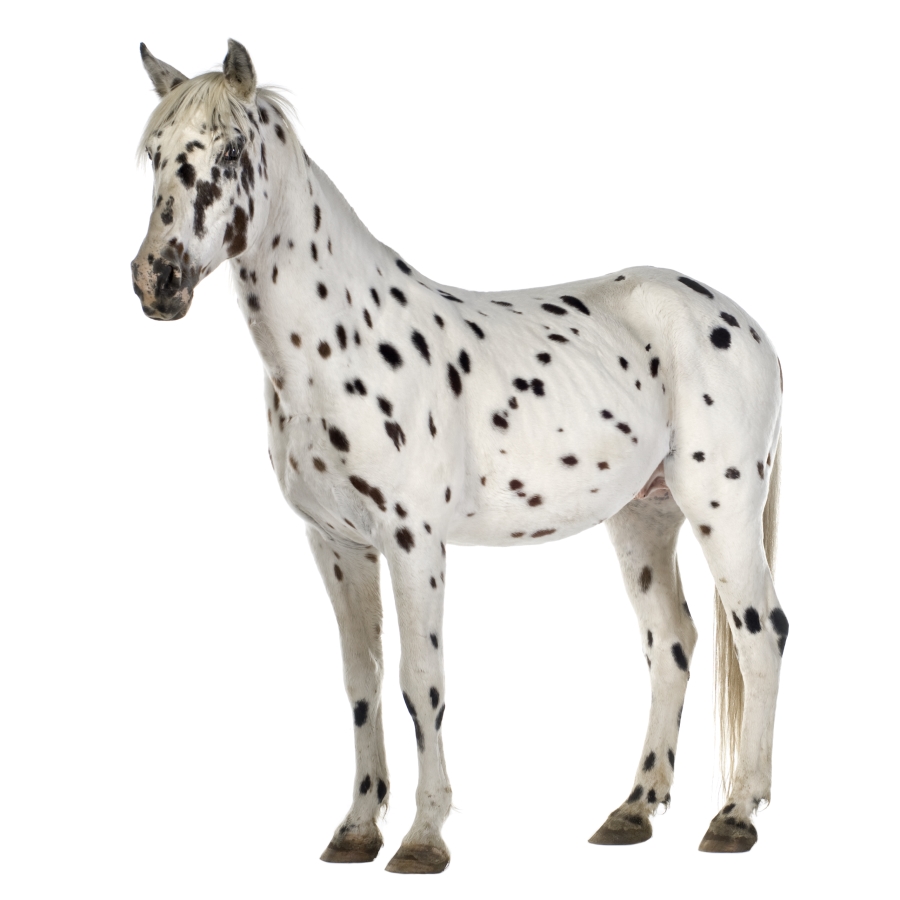
Genetic color modification – White factors
Horses with white factor genes are true white horses born white and should not be mistaken for being grey horses. The true white horse has pale/pink skin.
Different types of horses with white factors:
- Dominant white – born white with pink skin and brown or dark eyes.
- White-born leopard – nearly entirely white but have small patches of color on legs or a few spots.
- White frame overos – the foals are born white but die within a few days because of the lethal white syndrome.
- White sabinos – almost white horse with a small patch of color at the poll.
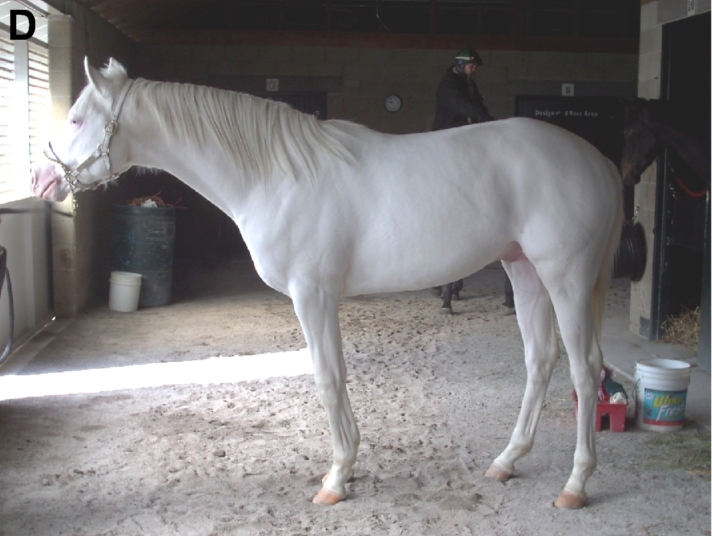
Photo: “File:DominantWhiteHorsesD.jpg” by Haase B, Brooks SA, Schlumbaum A, Azor PJ, Bailey E, et al. is licensed under CC BY-SA 2.5.
Other genetic modifications
Flaxen factor lightens mane in chestnuts
The flaxen factor lightens the mane in chestnuts. Haflingers are typical flaxen chestnuts.
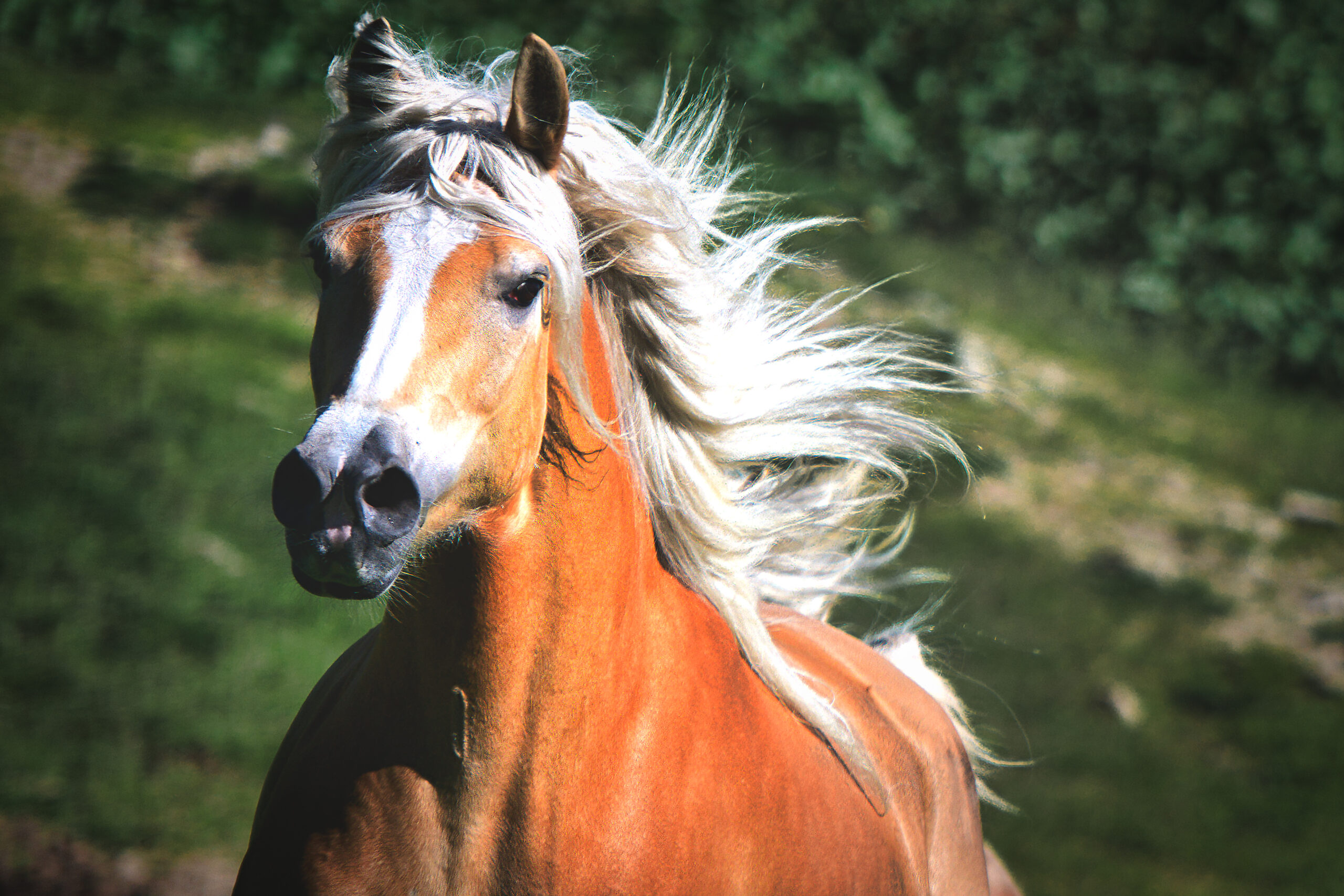
Mealy factor makes the muzzle and belly paler
The mealy factor also called pangare, makes the muzzle and underside of the belly paler. Common in Exmoor ponies.
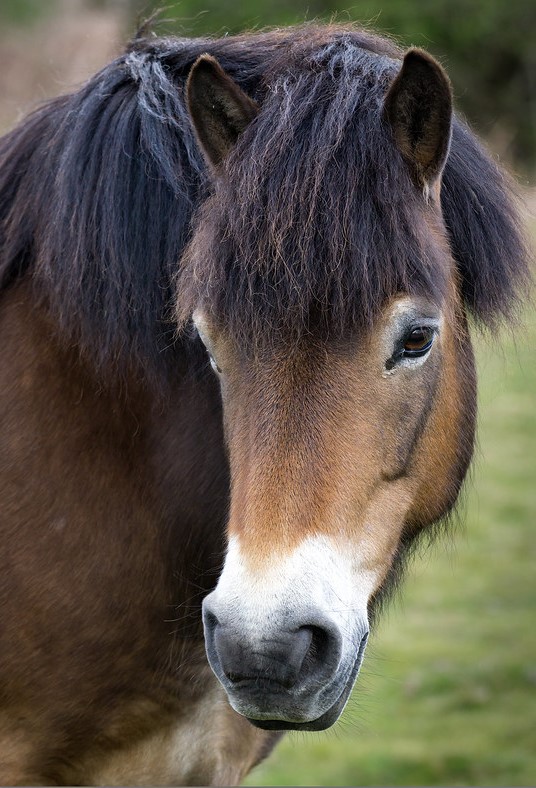
Photo: “Exmoor pony” by hehaden is licensed under CC BY-NC 2.0.
Sooty factor often leads to dapples
Sooty factor is mixing dark pigment with the basic color. Often leads to dapples.
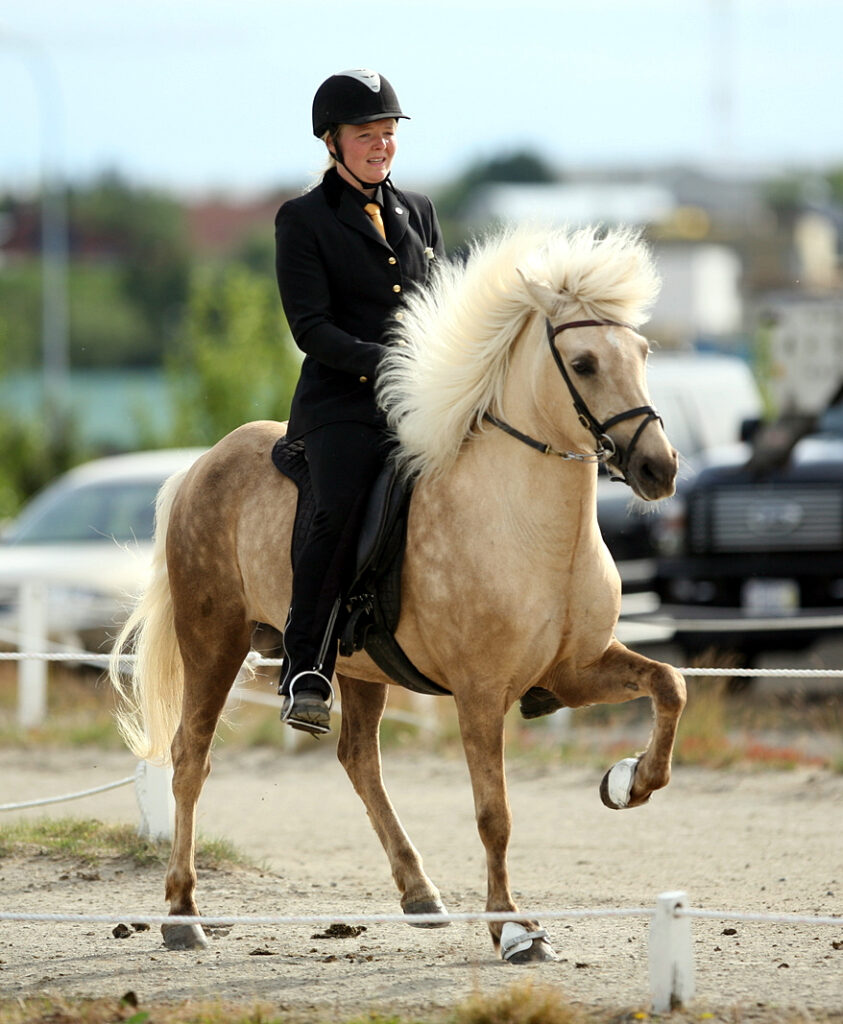
Photo: “File:271 Happadís frá Stangarholti.jpg” by Dagur Brynjólfsson from Hafnarfjordur, Iceland is licensed under CC BY-SA 2.0.
Dappling factor: gives dapples in other colors than grey
Grey dappling is a feature of progressive greying but with a dappling factor, you can also see it in a bay horse.

Foto: “Highland” by Elrenia_Greenleaf is licensed under CC BY-NC-SA 2.0.
Wall eyes, also called white eyes but the eyes are blue
Wall eyes also called white eyes or glass eyes. The eye color is blue or sometimes partially blue.

Conclusion
In conclusion, there are many horse colors and patterns that can be seen in different horses, with the basic colors being black, chestnut, bay, and brown — but also with many shades and variations of these colors. Finally, the patterns on a horse’s coat can also vary greatly, making for an infinite amount of different looks and characteristics in horses.

